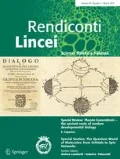Abstract
The present report recapitulates the contribution of the National Academy of Sciences, called Academy of the XL, and of its past president Gian Tommaso Scarascia Mugnozza to the research and conservation activities carried out since the nineties at the Presidential estate in Castelporziano.
Similar content being viewed by others
The richness and complexity of the forest ecosystem in the Presidential estate at Castelporziano, near Rome on the Tyrrhenian Sea, will be clearly apparent when reading about the most recent studies carried out in this unique natural area. The land of the estate is mainly flat along the coast, with old and new dunes that alternate with marshland, becomes hillier in the interior, and harbors the typical Mediterranean scrub, pine forests and oaks, home to numerous species of wildlife.
The Presidency of the Republic and the Presidential Secretariat have long been aware that the continuing expansion of the nearby city was endangering this precious and irreplaceable ecosystem and, as early as 1991, promoted a plan so as to ensure its protection and preservation.
Gian Tommaso Scarascia Mugnozza, a renowned agronomist in office as President of the National Academy of Sciences called Academy of the XL, was assigned the demanding task to organize a multidisciplinary program that could address the scientific and technical management of the forests and pastures, as well as the protection of the estate’s biodiversity. Scarascia Mugnozza devised an admirable, wide-ranging program that is still in use after 20 years. The complexity of the goals and the range of procedures associated with its realization required the establishment of an ad hoc Technical–Scientific Commission operating under the supervision of the Presidential Secretariat. The Commission comprised experts belonging to Italian universities, research institutions and government departments as well as members of the estate’s staff who ensured the necessary connection with the Estate Directory. From the very beginning, the Commission was chaired by Scarascia Mugnozza, while the Academy of the XL was assigned the responsibility to follow the development of the activities and take care of their administration.
It is worth delineating the operational structure of the program as it is apt to monitor the state of the forest ecosystem in other areas with a Mediterranean climate. The Commission coordinates distinct working groups of researchers and trainees who examine specific natural and external factors expected to influence the Castelporziano ecosystem, namely the atmosphere, the soil and groundwater quality, the relationships between the different vegetation types and the wildlife, as well as the impact of human activities.
Over the years, a vast amount of data was collected, analyzed and conveyed to a specific information system to allow an integrated and dynamic management of the multidisciplinary and multitemporal information acquired. To this end, Scarascia Mugnozza advocated the creation of an ‘Observatory for the study of coastal Mediterranean ecosystems’ that was established in 2003. The data storage system of the Observatory has proved to be a powerful tool in the elaboration of guidelines and rules for the protection of the ecological balance and, most importantly, for the planning of defensive measures. The studies carried out in Castelporziano are recorded in a series of volumes edited by the Academy of the XL.Footnote 1 They provide a unique resource for research to address the societal challenges concerning ecosystems, biodiversity and environmental policy in general.
Scarascia Mugnozza has always been proud of the entrustment to work for the conservation of the Castelporziano ecosystem and dedicated himself with passion to the activities of the Commission which he chaired until his death in 2011. His competence and vision have left their mark in our understanding of complex ecological networks and will continue to do so.
Notes
Publications on the Castelporziano ecosystem edited by the Academy of the XL, Rome.
VV.AA. (2001) Il Sistema Ambientale della Tenuta Presidenziale di Castelporziano. Ricerche sulla complessità di un ecosistema forestale costiero mediterraneo. Prima Serie. Scritti e Documenti XXVI, vols. I and II.
VV.AA. (2006) Il Sistema Ambientale della Tenuta Presidenziale di Castelporziano. Ricerche sulla complessità di un ecosistema forestale costiero mediterraneo Seconda serie. Scritti e Documenti XXXVII, vols. I, II, III.
Isotti R, Fanfani A, Tinelli A (2010) L’avifauna di Castelporziano. L’analisi della complessità ecologica delle comunità ornitiche come strumento di gestione territoriale.
Giordano E, Tinelli A, Capitoni B, Eberle A, Maffei L, Musicanti A, Recanatesi F, Scarascia Mugnozza GT (2010) Gli alberi monumentali della Tenuta di Castelporziano. English translation by Gajeri E (2011) The Monumental Trees of the Estate of Castelporziano.
Scarascia Mugnozza GT (2011) Introduzione e sintesi degli studi e delle ricerche.
Tinelli A, Folletto A, Manfredi Frattarelli F, Maffei L, Musicanti A, Recanatesi F (2012) Il Sistema Ambientale della Tenuta Presidenziale di Castelporziano. Le zone umide.
Maffei L, Folletto A, Tinelli A (2013) Bibliografia ragionata sul sistema ambientale della Tenuta Presidenziale di Castelporziano dal 1885 ad oggi.
VV.AA. (2013) Il Sistema Ambientale della Tenuta Presidenziale di Castelporziano. Ricerche sulla complessità di un ecosistema forestale costiero mediterraneo. Terza Serie. Scritti e Documenti XLVI, vols. I, II.
Author information
Authors and Affiliations
Corresponding author
Rights and permissions
About this article
Cite this article
Chiancone, E. Research at the Presidential estate in Castelporziano: role of Gian Tommaso Scarascia Mugnozza and the Accademia Nazionale delle Scienze detta dei XL. Rend. Fis. Acc. Lincei 26 (Suppl 3), 267–268 (2015). https://doi.org/10.1007/s12210-014-0327-8
Received:
Accepted:
Published:
Issue Date:
DOI: https://doi.org/10.1007/s12210-014-0327-8




